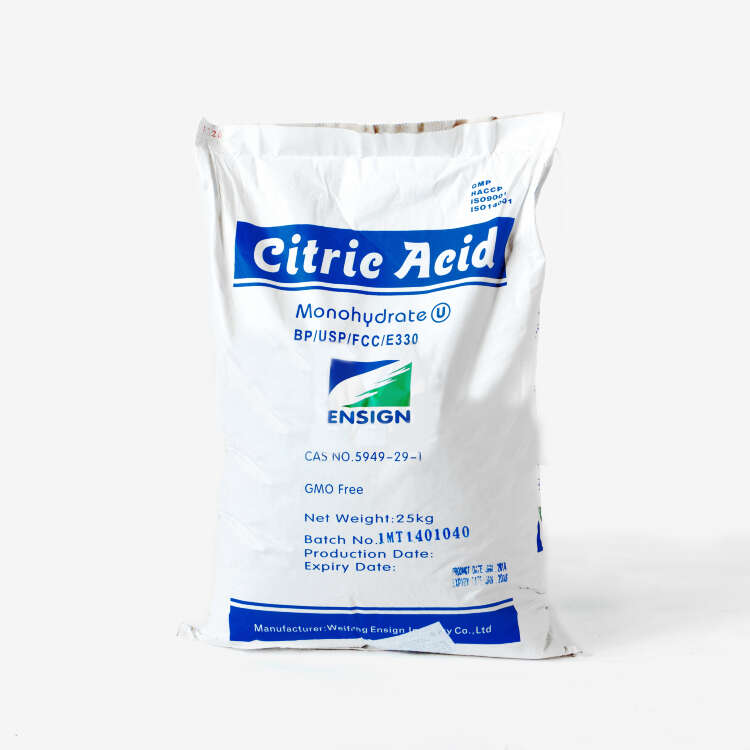Citric acid monohydrate E330
Citric acid monohydrate E330
Citric acid monohydrate E330 it has a chemical name - 3-hydroxy-3-carboxypentane-1,5-dionic acid and the formula C6H8O7xh2O.
Being one of the most common food additives, it is present in all living cells as an important intermediate of metabolism and is fully absorbed by the human body. It is found in almost all fruits, conifers, leaves of plants.Its industrial production is carried out by the method of microbiological synthesis using the fungus Aspergillus niger from organic sugar-containing raw materials. The finished product is small white crystals that are highly soluble in water, slightly soluble in alcohol and insoluble in organic solvents.
Citric acid monohydrate is allowed for use in all countries of the world, including in the Russian Federation, where it is produced according to GOST 903-2004.
Technological recommendations
Citric acid monohydrate is widely used in various branches of the food industry as an acidifier, acidity regulator, hydrolysis catalyst and color stabilizer.
It is extremely widely used in carbonated and non-carbonated, alcoholic and non-alcoholic beverages in order to give them a feeling of freshness. It also protects products from the decomposing influence of traces of heavy metals in them.
The excellent taste properties of citric acid make it an ideal component in the preparation of confectionery, caramels, ice cream, jams, jellies, fruit and berry preserves.
Citric acid is an integral part of many cosmetic preparations: elixirs, lotions, creams, shampoos, hair fixers, etc. It ennobles tobacco by binding its volatile bases, is used in winemaking and the leather industry. In lead poisoning, it converts lead into a difficult-to-digest compound.The table shows the approximate doses of adding citric acid monohydrate to various products:
| Product Name | Citric acid content, % |
| Hard caramels | 0,8 - 1,5 |
| Jelly caramels | 0,5 - 1,5 |
| Sour dragees | 1,0 - 2,0 |
| Cakes and pastries | 0,2 - 0,4 |
| Ice cream | 0,2 - 0,5 |
| Juices | 0,1 - 0,3 |
| Soft drinks | 0,2 - 0,4 |
| Wines | 0,1 - 0,2 |
| Liqueurs | 0,3 - 0,5 |
| Canned vegetables and fruit | 0,1 - 0,7 |
| Canned fish | lowering into a 2% solution |
| Canned meat | 0,2 - 0,5 |
| Creams, lotions | 0,05 - 0,15 |
| Bakery products | 0,5 - 1,0 |
| Baby food | 0,02 - 0,04 |
| Fats, margarine | 0,01 - 0,05 |
The formation of complexes of citric acid with iron compounds is based on its washing with a solution of the steam-water path of power units at power plants, heat exchangers and other equipment. To do this, prepare its 2-3% solution inhibited by ammonium monocitrate, atropine or other effective inhibitors. This solution is injected already hot or heated inside the steam-water tract to 100 degrees. All iron oxides are transferred to the solution at the same time, and at a certain flow rate, the danger of the formation of local blockages of scale and rust in the washed circuit is prevented.
Specifications
| Volatile organic impurities | Withstands the test |
| Bacterial contamination, IU/mg | max. 0.5 |
| Aluminum, ppm | max. 0.2 |
| Iron, ppm | max. 5.0 |
| Heavy metals (as Pb), ppm | max. 5.0 |
| Mercury, ppm | max. 1.0 |
| Arsenic, ppm | max. 1.0 |
| Lead, ppm | max. 0.5 |
| Sulphate ash, % | max. 0.05 |
| Chlorides, ppm | max. 50 |
| Calcium, ppm | max. 75 |
| Oxalates, ppm | max. 100 |
| Sulfates, ppm | max. 150 |
| Water content, % | 7.5 – 8.8 |
| The content of the main substance, % | 99.5 – 100.5 |
| Appearance | Colorless crystals or white crystalline powder |
Didn't find the required product? Do you have any questions?
If you have any questions about the availability and assortment of goods, or other questions, you can call us by phone +7 (4212) 476-887, +7 (924) 208-4800, +7 (924) 305-4785.
Or just leave a request. We will contact you and give you an answer.



